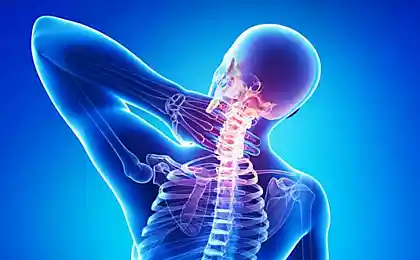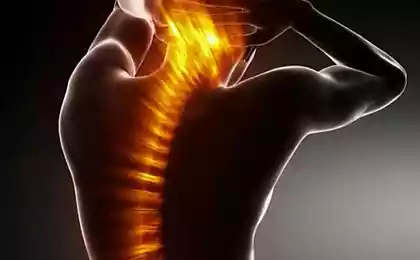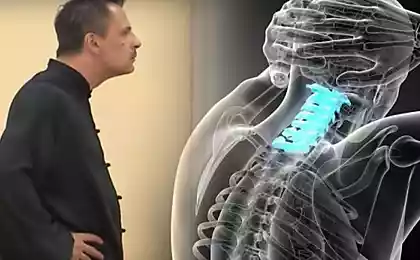473
Vertebral artery syndrome in cervical osteochondrosis
Vertebral artery syndrome (the syndrome vertebrobazilyarnoy failure) is a symptom caused by a violation of the nutrient supply to brain cells due to the pathology of vessels located at the back of the neck near the spine.
The change of blood flow in the vertebral arteries causes headache, especially in occiput, dizziness, blurred vision, and coordination. The causes of the disease can be nevertebralnah (congenital anomalies, most often, the small diameter of the vertebral vessels, or atherosclerotic changes) and vertebral (associated with pathology of the spine), when the arteries are compressed from the outside of the salt growths, deformities of the cervical vertebrae. However, in practice, very often there is a combination of these factors.
Fifteen million four hundred forty thousand six hundred five
Vertebral artery syndrome is rare in young people, the only exceptions are gross congenital anomalies with almost complete narrowing of the lumen of the blood vessel. Any problems that arise and increase with the progression of cervical degenerative disc disease. By the age of 50 70-80% of headaches in the occipital region can be attributed to the syndrome vertebrobazilyarnoy failure.
The symptoms of vertebral artery in cervical osteochondrosis
Headache. It is localized predominantly in the occipital region, sometimes spreading to the forehead, temple, eye socket, ear. Often a constant, pressing, paroxysmal, sometimes with feeling of pulsation. In nature, unilateral, depending on the respective involvement of the vertebral artery.
Vestibular disorders – in particular, dizziness, nausea and sometimes ending with vomiting, relieving symptoms. There may be dizziness (lightheadedness) or its short-term loss, as well as the noise and ringing in the head, unsteadiness when walking, koordinatornyh violations.
Changes to hearing: a short hearing loss or noise, ringing in the ear.
Visual symptoms: reduced vision, a sense of "veil" before the eyes, sometimes pain, pain in both or one eye.
Symptoms of the heart and blood vessels are observed infrequently, but in individuals with existing diseases or prone to them, the syndrome of the vertebral artery can cause angina, hypertensive crisis, increased blood pressure.
As a rule, for vertebrobazilyarnoy failure wavelike, when exacerbations are replaced more or less prolonged remissions. However, the elderly with frequent changes of the cervical spine in combination with vascular malformations and atherosclerosis symptoms of varying severity may be observed constantly.
Syndrome treatment
Before you start treatment, it is necessary to conduct a detailed examination. Prevent acute impairment of cerebral circulation (stroke), the manifestations of which, especially when sudden beginning, accompanied by high blood pressure, are very similar to vertebral artery syndrome in osteochondrosis. In severe cases the patient becomes incapacitated and require hospitalization in the neurological Department of a hospital, light therapy can be performed in a clinic.
Non-drug treatment:
Treatment of vertebral artery syndrome at home
Home treatment can be used only in mild cases or after consultation with the attending physician in conjunction with medication. National recipe:
Garlic: 150 g garlic, peel and pass through a press, place in a sealable container and refrigerate for three days. Then squeeze the juice through cheesecloth, mixed with honey and lemon juice in a ratio of 1:1:1. Take 1 tablespoon before bedtime.
Hawthorn: 1 tablespoon of dried fruits pour boiling water in a volume of 100 ml. allow to stand 15 minutes and dose to 1 tablespoon three times a day.
After the acute manifestations can begin to do physical therapy and exercise constantly at least once a day in the morning, it is especially important to stretch your cervical:
P. S. And remember, only by changing their consumption — together we change the world! © Join us at Facebook , Vkontakte, Odnoklassniki
Source: kozdor.ru/odna_stat.php?id=792
The change of blood flow in the vertebral arteries causes headache, especially in occiput, dizziness, blurred vision, and coordination. The causes of the disease can be nevertebralnah (congenital anomalies, most often, the small diameter of the vertebral vessels, or atherosclerotic changes) and vertebral (associated with pathology of the spine), when the arteries are compressed from the outside of the salt growths, deformities of the cervical vertebrae. However, in practice, very often there is a combination of these factors.
Fifteen million four hundred forty thousand six hundred five
Vertebral artery syndrome is rare in young people, the only exceptions are gross congenital anomalies with almost complete narrowing of the lumen of the blood vessel. Any problems that arise and increase with the progression of cervical degenerative disc disease. By the age of 50 70-80% of headaches in the occipital region can be attributed to the syndrome vertebrobazilyarnoy failure.
The symptoms of vertebral artery in cervical osteochondrosis
Headache. It is localized predominantly in the occipital region, sometimes spreading to the forehead, temple, eye socket, ear. Often a constant, pressing, paroxysmal, sometimes with feeling of pulsation. In nature, unilateral, depending on the respective involvement of the vertebral artery.
Vestibular disorders – in particular, dizziness, nausea and sometimes ending with vomiting, relieving symptoms. There may be dizziness (lightheadedness) or its short-term loss, as well as the noise and ringing in the head, unsteadiness when walking, koordinatornyh violations.
Changes to hearing: a short hearing loss or noise, ringing in the ear.
Visual symptoms: reduced vision, a sense of "veil" before the eyes, sometimes pain, pain in both or one eye.
Symptoms of the heart and blood vessels are observed infrequently, but in individuals with existing diseases or prone to them, the syndrome of the vertebral artery can cause angina, hypertensive crisis, increased blood pressure.
As a rule, for vertebrobazilyarnoy failure wavelike, when exacerbations are replaced more or less prolonged remissions. However, the elderly with frequent changes of the cervical spine in combination with vascular malformations and atherosclerosis symptoms of varying severity may be observed constantly.
Syndrome treatment
Before you start treatment, it is necessary to conduct a detailed examination. Prevent acute impairment of cerebral circulation (stroke), the manifestations of which, especially when sudden beginning, accompanied by high blood pressure, are very similar to vertebral artery syndrome in osteochondrosis. In severe cases the patient becomes incapacitated and require hospitalization in the neurological Department of a hospital, light therapy can be performed in a clinic.
Non-drug treatment:
- wearing the orthopedic collar Trench that will support your neck in physiological position and to reduce the load on the spine;
- manual therapy should be conducted by a competent physician only after a CT scan of the cervical;
- acupuncture;
- physiotherapy (magnetotherapy, laser cervical spine, d arsonvalization scalp) can be assigned in the absence of thyroid disease and at normal pressure.
Treatment of vertebral artery syndrome at home
Home treatment can be used only in mild cases or after consultation with the attending physician in conjunction with medication. National recipe:
Garlic: 150 g garlic, peel and pass through a press, place in a sealable container and refrigerate for three days. Then squeeze the juice through cheesecloth, mixed with honey and lemon juice in a ratio of 1:1:1. Take 1 tablespoon before bedtime.
Hawthorn: 1 tablespoon of dried fruits pour boiling water in a volume of 100 ml. allow to stand 15 minutes and dose to 1 tablespoon three times a day.
After the acute manifestations can begin to do physical therapy and exercise constantly at least once a day in the morning, it is especially important to stretch your cervical:
- sternocleidomastoid movement with the fixation of the chin near the chest for 5 seconds;
- the head tilts right and left, while the shoulders remain stationary;
- the rotation of the head clockwise and back;
- hovering on the bar promotes muscle relaxation;
- swinging on the swings to strengthen the vestibular system and improve its sustainability.
P. S. And remember, only by changing their consumption — together we change the world! © Join us at Facebook , Vkontakte, Odnoklassniki
Source: kozdor.ru/odna_stat.php?id=792
So You also prepared: 9 fantastic ideas!
About children, about childhood, about the period of "Golden eggs" that spoil our life...























